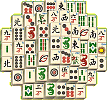Introduction
Mahjong solitaire or MahJongg solitaire also known as Shanghai solitaire, single-player mahjong or one-player mahjong, is a solitaire matching game that uses a set of Mahjong tiles. The 144 tiles are arranged in special layouts with their faces upwards. A tile that can be moved left or right without disturbing other tiles is said to be exposed. Exposed pairs of identical tiles (Flower and Seasons tiles in the same group being considered identical) are removed from the layout one at a time, gradually exposing the lower layers to play. The aim of the game is to clear the layout by pairing up all the tiles. The game is finished when either the layout is empty, or there are no exposed pairs remaining.
Object of the Game
The object of the game is to clear the playing area of tiles by matching pairs of tiles.
Players can remove only those matching pairs of tiles where each tile has at least one side (left or right) free and no other tiles placed on top.
Matching tile pairs can be removed by clicking on each tile in the pair.
Reshuffle button can be used when no moves are available. A maximum of 5 reshuffles per game is allowed.
Playing the Game
A player can only remove the tiles one pair at a time. There are a total of 72 pairs in a game of MahJong Solitaire. Like cards, the tiles have standard suits. These suits are Characters, Bamboos, Circles, Dragons, Winds, Seasons, and Flowers as shown in the table below:
| Characters (4 of each) |
Bamboos (4 of each) |
Circles (4 of each) |
Dragons, etc. (4 of each) |
Winds (4 of each) |
Seasons (1 of each) |
Flowers (1 of each) |
 |
 |
 |
 |
 |
 |
 |
When matching pairs, Seasons and Flowers are the only suits you do not need to match exactly. Any Season or Flower combination counts as a pair because there is only one of each tile.
When no pairs are left, you may use a shuffle. Each time you start a game, you are granted 5 shuffles. When you have no more pairs and no more shuffles, the game is over. If you clear the board, you move to the next level, which will have a different layout.
Mahjong Strategy Tips
1. Although each tile layout requires a unique approach, the general strategy is to keep removing matching tiles in such a way that each removal would open up more possibilities for future tile matching.
2. You should open up new tiles with every pair they eliminate. Choosing obvious pairs every time, such as those from the top levels, will often lose the game by leaving essential tiles under cover.
3. In certain situations obtaining matching tiles after reshuffling can be either theoretically impossible or highly unlikely.
The key is to avoid getting into positions where the above is likely to happen.
4. It is very crucial to focus and give your full attention and concentration to the game, when your mind wanders, even for a second, it will cost you a lot of time to refocus.
5. React fast. Time is the most important factor in the game, so it is imperative to be fast. Fast reaction means making the correct decision given the current situation as the result of previous decisions.
6. You will be required to imagine your movements several steps ahead. The game might look playable now, but if you don’t look ahead and you make the wrong move then the game could end with no solutions.
7. Elaborate your visual memory. Some of Mahjong characters on the tiles look quite similar, especially when you have to quickly scan many tiles over and over. It is important to be able to distinguish all the tiles correctly, and often memorize where you last saw “that piece”.
